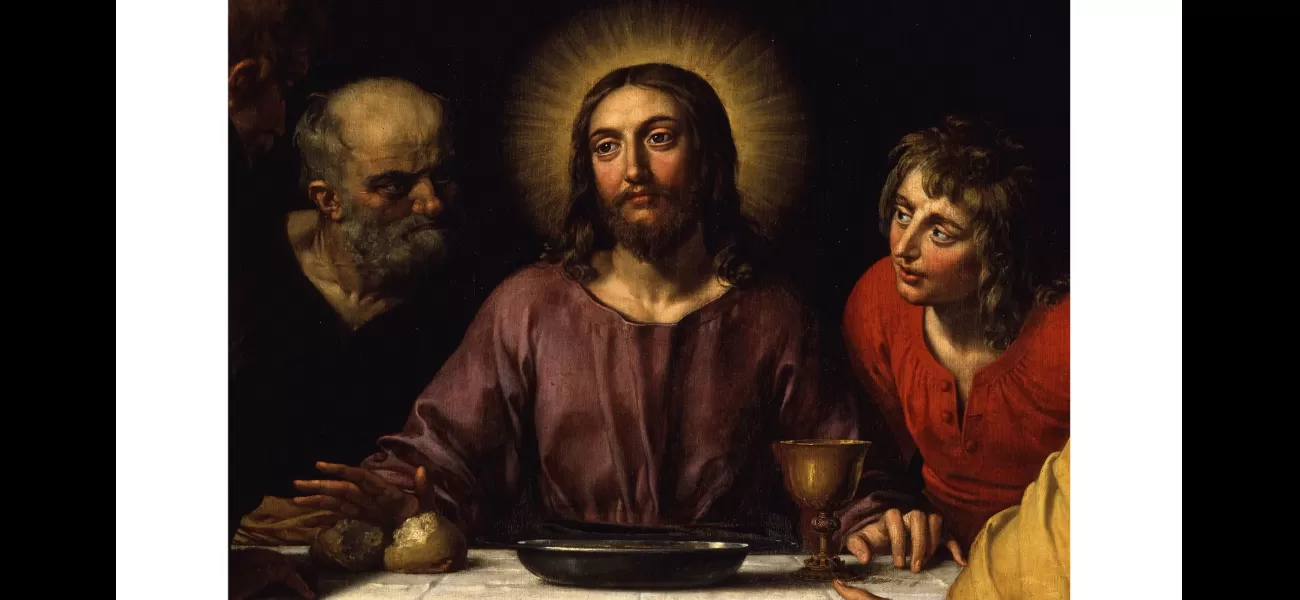Who has the true Holy Grail?
People go to see and pray over these objects, but is there truly a real grail and does it actually exist?
August 18th 2024.

When you step foot into a church or cathedral, you can't help but feel a sense of tranquility wash over you. The peaceful atmosphere is almost palpable as you take in the stunning architecture, breathtaking artworks, and centuries of history and faith that have withstood the test of time. But there's something even more special waiting for you in certain chapels or museums – the holiest of items, the Holy Grail.
But what exactly makes this cup the Holy Grail? And why are there so many cups claiming to be the same one? It's said that there are around 200 cups in Europe alone, each one believed to be the cup used by Jesus Christ at the Last Supper. People from all over flock to see these cups and offer prayers, but the question still remains – which one is the real Holy Grail, if it even exists?
The Holy Grail has become deeply ingrained in our collective imagination, often symbolizing a quest for something unattainable. It's a common theme in literature, art, and movies, and we even use the term "holy grail" to refer to our ultimate goals. Even in pop culture, the Holy Grail has made its mark – remember Dan Brown's bestseller, "The Da Vinci Code," or Indiana Jones reaching for the "cup of a carpenter" in "The Last Crusade"?
But if we strip away all the modern interpretations, the Holy Grail is simply believed to be the cup used by Jesus at the Last Supper. For believers, this cup holds immense significance as it is the same one that Christ drank from before his arrest, sentencing, and crucifixion. Over the centuries, legends have also emerged about the grail possessing miraculous powers, adding to the intrigue and fascination surrounding it.
However, not everyone believes that the actual cup from the Last Supper still exists. Joanne Pierce, a professor of religious studies, believes that the Holy Grail is more of a cultural reality than a religious one. For her, it's a symbol rather than a tangible object. But for many others, the search for the Holy Grail is very real, and there are numerous places around the world where it is said to reside.
Valencia, Léon, Genoa, and many other places claim to possess the Holy Grail. Some believe that they can feel the mystical power of the Grail if they visit these places – whether it's the chapel in Valencia that houses the "Santo Cáliz" (holy chalice), or the mountain of Montserrat outside Barcelona, or even the Polish countryside where the Knights Templar may have hidden it. The medieval legend of Joseph of Arimathea bringing the Grail to Glastonbury Tor in England also adds to its mystery.
But for the people of Valencia, the Holy Grail is not just a legend – it's a real object that holds great significance. The cathedral in Valencia houses a chapel built specifically to showcase the "Santo Cáliz," believed to be the same cup used by Jesus at the Last Supper. According to tradition, the cup was brought to Spain by St. Peter and has been revered by Christians for centuries.
The idea of the Holy Grail has been a source of fascination for centuries, especially during the time of the Crusades. As people traveled back and forth between Europe and the Holy Land, there was a growing interest in artifacts related to Jesus' life on Earth. This led to the discovery of numerous supposed Holy Grails, many of which were brought back to Europe during the medieval period.
Relics have always played a significant role in Christianity, with believers praying at the graves of martyrs and considering objects touched by these holy figures to be imbued with grace. But over time, relics also became a lucrative business, with people making pilgrimages to these sacred sites, boosting the local economy. The Crusades also had a political angle, with the discovery of relics like the lance that pierced Jesus' side being seen as a divine affirmation of their mission to "liberate" the Holy Land.
However, with the increasing demand for relics, there were also cases of fraud and the creation of fake relics. This is why some relics, like the supposed pieces of the true cross, are so numerous that they couldn't possibly be authentic. It's a similar story with the Holy Grail – while it may have started out as a sacred relic for Christians, it has also been linked to other legends, like that of King Arthur, thanks to chivalric poetry.
In the end, whether the Holy Grail is a religious or cultural reality, it continues to capture our imagination and inspire us to embark on our own quests. And who knows, maybe one day the real Holy Grail will be found, but until then, the search for it will continue to captivate us.
Wherever one may wander, the ambiance is often indistinguishable. Whether it be a grand church or a towering cathedral, a solemn quietude falls upon the space. One cannot help but be captivated by the intricate designs, the masterful artworks, and the rich history and faith that have stood steadfast through the test of time. And then, one may find themselves in a special chapel or museum, where the most sacred of objects resides. Enclosed in a glass case stands a legendary item: the Holy Grail.
Or is it truly the Holy Grail? What sets this particular cup apart from any other? In Europe alone, there are said to be approximately 200 cups, each one believed to be the one used by Jesus Christ at the Last Supper. Devotees come from far and wide to see these cups, to pray over them. But which one is the true Holy Grail, if there even is one at all?
The concept of the Holy Grail has become deeply ingrained in our collective imagination. The idea of embarking on a quest is a recurring theme in literature, art, and movies. We often refer to our ultimate goals, the ones that always seem just out of reach, as the "holy grail." The term has even made its way into popular culture, with Dan Brown's bestselling novel "The Da Vinci Code" and the iconic scene in "Indiana Jones and the Last Crusade" where Harrison Ford reaches for the "cup of a carpenter."
Even stories that have no connection to Christianity often revolve around quests, such as the beloved Harry Potter series or "Lord of the Rings." But if we strip away the modern connotations, we are left with a simple explanation: the Holy Grail is believed to be the cup used by Jesus at the Last Supper. This sacred chalice, which Christ drank from before his arrest, sentencing, and crucifixion, holds great significance for Christians around the world. And over time, legends have emerged about "grails" possessing miraculous powers, only adding to the intrigue and fascination surrounding the object.
However, Joanne Pierce, a professor of religious studies, raises an important point: is the actual cup from the Last Supper still in existence? "Jesus may have used a cup at the Last Supper, but according to some Gospel accounts, the room was already prepared by someone else," she explains. "So it's possible that it may not have been his cup."
For Pierce, a Catholic, the Holy Grail holds more symbolic value than tangible reality. She sees it as a cultural phenomenon rather than a religious one. But for many people, the grail is a real object, one that can be seen in places like Valencia, Léon, or Genoa, among others. Some even believe they can feel the mystical power of the Grail if they visit places where it's said to be hidden, such as Montserrat in Spain or the Polish countryside. And in medieval times, the mysterious hill of Glastonbury Tor in England was believed to be the resting place of the Grail, brought there by Joseph of Arimathea after Jesus' death.
In Valencia, Spain, the cathedral houses a special chapel built specifically for the "Santo Cáliz," or "holy chalice." According to the cathedral's website, tradition holds that this cup is the same one used by Jesus at the Last Supper to institute the Eucharist. They believe that St. Peter took it to Rome, and it eventually made its way to Spain in the 3rd century.
Valencia's tourist board also markets the cup as "the Holy Chalice...used by Jesus Christ at the Last Supper." It's no surprise that claiming to have the Holy Grail is a major draw for tourism. This has been the case since the medieval period when Europeans returning from the Crusades would bring back relics from Jerusalem.
However, collecting relics has not always been solely about getting closer to God. As Pierce explains, relics have always held a central role in Christianity. In ancient Rome, the idea of saints interceding for prayers was taken from the patronage system, where patrons acted as intermediaries for the ordinary people. When early Christians were martyred, believers would pray at their graves, and this practice continued into Christianity. But it wasn't just the graves of martyrs that were considered holy; anything they had touched or been in contact with was believed to hold the same grace. So it's no wonder that the cup used by Jesus during the Last Supper is considered the holiest of objects.
During the Crusades, interest in Jesus' life on Earth increased, and people were constantly traveling between Europe and the Holy Land in search of artifacts. This is why most of the supposed Holy Grails in Europe arrived during this time. "It's similar to the modern-day interest in the paranormal," says Mathew Schmalz, a professor of religious studies. "In the Middle Ages, it reached a level of public consciousness that it hadn't before."
But as the centuries passed, the pursuit of relics was not always purely driven by religious motives. There were also economic incentives, with pilgrimage becoming a lucrative business for those who had relics. Relics also held political significance, especially during the Crusades when possessing certain items, such as the lance that pierced Jesus' side, was seen as a divine sign that they were on a mission to "liberate" the Holy Land.
This is also one reason why there are so many supposed relics of the Holy Grail; some were simply created as a means to attract pilgrims and boost the local economy. As Schmalz points out, "You could build a city with the amount of wood that is claimed to be from the true cross."
Although the Holy Grail may have its roots in Christianity, it has also become a part of other cultures and legends, such as the tales of King Arthur. This connection can be traced back to medieval poetry and chivalric tales, according to Pierce. The legend of King Arthur and the Holy Grail has been romanticized and adapted in various forms of literature and media, adding yet another layer to the mystery and fascination surrounding this sacred object.
But what exactly makes this cup the Holy Grail? And why are there so many cups claiming to be the same one? It's said that there are around 200 cups in Europe alone, each one believed to be the cup used by Jesus Christ at the Last Supper. People from all over flock to see these cups and offer prayers, but the question still remains – which one is the real Holy Grail, if it even exists?
The Holy Grail has become deeply ingrained in our collective imagination, often symbolizing a quest for something unattainable. It's a common theme in literature, art, and movies, and we even use the term "holy grail" to refer to our ultimate goals. Even in pop culture, the Holy Grail has made its mark – remember Dan Brown's bestseller, "The Da Vinci Code," or Indiana Jones reaching for the "cup of a carpenter" in "The Last Crusade"?
But if we strip away all the modern interpretations, the Holy Grail is simply believed to be the cup used by Jesus at the Last Supper. For believers, this cup holds immense significance as it is the same one that Christ drank from before his arrest, sentencing, and crucifixion. Over the centuries, legends have also emerged about the grail possessing miraculous powers, adding to the intrigue and fascination surrounding it.
However, not everyone believes that the actual cup from the Last Supper still exists. Joanne Pierce, a professor of religious studies, believes that the Holy Grail is more of a cultural reality than a religious one. For her, it's a symbol rather than a tangible object. But for many others, the search for the Holy Grail is very real, and there are numerous places around the world where it is said to reside.
Valencia, Léon, Genoa, and many other places claim to possess the Holy Grail. Some believe that they can feel the mystical power of the Grail if they visit these places – whether it's the chapel in Valencia that houses the "Santo Cáliz" (holy chalice), or the mountain of Montserrat outside Barcelona, or even the Polish countryside where the Knights Templar may have hidden it. The medieval legend of Joseph of Arimathea bringing the Grail to Glastonbury Tor in England also adds to its mystery.
But for the people of Valencia, the Holy Grail is not just a legend – it's a real object that holds great significance. The cathedral in Valencia houses a chapel built specifically to showcase the "Santo Cáliz," believed to be the same cup used by Jesus at the Last Supper. According to tradition, the cup was brought to Spain by St. Peter and has been revered by Christians for centuries.
The idea of the Holy Grail has been a source of fascination for centuries, especially during the time of the Crusades. As people traveled back and forth between Europe and the Holy Land, there was a growing interest in artifacts related to Jesus' life on Earth. This led to the discovery of numerous supposed Holy Grails, many of which were brought back to Europe during the medieval period.
Relics have always played a significant role in Christianity, with believers praying at the graves of martyrs and considering objects touched by these holy figures to be imbued with grace. But over time, relics also became a lucrative business, with people making pilgrimages to these sacred sites, boosting the local economy. The Crusades also had a political angle, with the discovery of relics like the lance that pierced Jesus' side being seen as a divine affirmation of their mission to "liberate" the Holy Land.
However, with the increasing demand for relics, there were also cases of fraud and the creation of fake relics. This is why some relics, like the supposed pieces of the true cross, are so numerous that they couldn't possibly be authentic. It's a similar story with the Holy Grail – while it may have started out as a sacred relic for Christians, it has also been linked to other legends, like that of King Arthur, thanks to chivalric poetry.
In the end, whether the Holy Grail is a religious or cultural reality, it continues to capture our imagination and inspire us to embark on our own quests. And who knows, maybe one day the real Holy Grail will be found, but until then, the search for it will continue to captivate us.
Wherever one may wander, the ambiance is often indistinguishable. Whether it be a grand church or a towering cathedral, a solemn quietude falls upon the space. One cannot help but be captivated by the intricate designs, the masterful artworks, and the rich history and faith that have stood steadfast through the test of time. And then, one may find themselves in a special chapel or museum, where the most sacred of objects resides. Enclosed in a glass case stands a legendary item: the Holy Grail.
Or is it truly the Holy Grail? What sets this particular cup apart from any other? In Europe alone, there are said to be approximately 200 cups, each one believed to be the one used by Jesus Christ at the Last Supper. Devotees come from far and wide to see these cups, to pray over them. But which one is the true Holy Grail, if there even is one at all?
The concept of the Holy Grail has become deeply ingrained in our collective imagination. The idea of embarking on a quest is a recurring theme in literature, art, and movies. We often refer to our ultimate goals, the ones that always seem just out of reach, as the "holy grail." The term has even made its way into popular culture, with Dan Brown's bestselling novel "The Da Vinci Code" and the iconic scene in "Indiana Jones and the Last Crusade" where Harrison Ford reaches for the "cup of a carpenter."
Even stories that have no connection to Christianity often revolve around quests, such as the beloved Harry Potter series or "Lord of the Rings." But if we strip away the modern connotations, we are left with a simple explanation: the Holy Grail is believed to be the cup used by Jesus at the Last Supper. This sacred chalice, which Christ drank from before his arrest, sentencing, and crucifixion, holds great significance for Christians around the world. And over time, legends have emerged about "grails" possessing miraculous powers, only adding to the intrigue and fascination surrounding the object.
However, Joanne Pierce, a professor of religious studies, raises an important point: is the actual cup from the Last Supper still in existence? "Jesus may have used a cup at the Last Supper, but according to some Gospel accounts, the room was already prepared by someone else," she explains. "So it's possible that it may not have been his cup."
For Pierce, a Catholic, the Holy Grail holds more symbolic value than tangible reality. She sees it as a cultural phenomenon rather than a religious one. But for many people, the grail is a real object, one that can be seen in places like Valencia, Léon, or Genoa, among others. Some even believe they can feel the mystical power of the Grail if they visit places where it's said to be hidden, such as Montserrat in Spain or the Polish countryside. And in medieval times, the mysterious hill of Glastonbury Tor in England was believed to be the resting place of the Grail, brought there by Joseph of Arimathea after Jesus' death.
In Valencia, Spain, the cathedral houses a special chapel built specifically for the "Santo Cáliz," or "holy chalice." According to the cathedral's website, tradition holds that this cup is the same one used by Jesus at the Last Supper to institute the Eucharist. They believe that St. Peter took it to Rome, and it eventually made its way to Spain in the 3rd century.
Valencia's tourist board also markets the cup as "the Holy Chalice...used by Jesus Christ at the Last Supper." It's no surprise that claiming to have the Holy Grail is a major draw for tourism. This has been the case since the medieval period when Europeans returning from the Crusades would bring back relics from Jerusalem.
However, collecting relics has not always been solely about getting closer to God. As Pierce explains, relics have always held a central role in Christianity. In ancient Rome, the idea of saints interceding for prayers was taken from the patronage system, where patrons acted as intermediaries for the ordinary people. When early Christians were martyred, believers would pray at their graves, and this practice continued into Christianity. But it wasn't just the graves of martyrs that were considered holy; anything they had touched or been in contact with was believed to hold the same grace. So it's no wonder that the cup used by Jesus during the Last Supper is considered the holiest of objects.
During the Crusades, interest in Jesus' life on Earth increased, and people were constantly traveling between Europe and the Holy Land in search of artifacts. This is why most of the supposed Holy Grails in Europe arrived during this time. "It's similar to the modern-day interest in the paranormal," says Mathew Schmalz, a professor of religious studies. "In the Middle Ages, it reached a level of public consciousness that it hadn't before."
But as the centuries passed, the pursuit of relics was not always purely driven by religious motives. There were also economic incentives, with pilgrimage becoming a lucrative business for those who had relics. Relics also held political significance, especially during the Crusades when possessing certain items, such as the lance that pierced Jesus' side, was seen as a divine sign that they were on a mission to "liberate" the Holy Land.
This is also one reason why there are so many supposed relics of the Holy Grail; some were simply created as a means to attract pilgrims and boost the local economy. As Schmalz points out, "You could build a city with the amount of wood that is claimed to be from the true cross."
Although the Holy Grail may have its roots in Christianity, it has also become a part of other cultures and legends, such as the tales of King Arthur. This connection can be traced back to medieval poetry and chivalric tales, according to Pierce. The legend of King Arthur and the Holy Grail has been romanticized and adapted in various forms of literature and media, adding yet another layer to the mystery and fascination surrounding this sacred object.
[This article has been trending online recently and has been generated with AI. Your feed is customized.]
[Generative AI is experimental.]
0
0
Submit Comment





